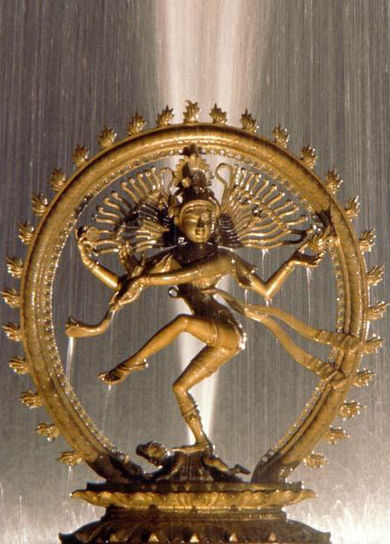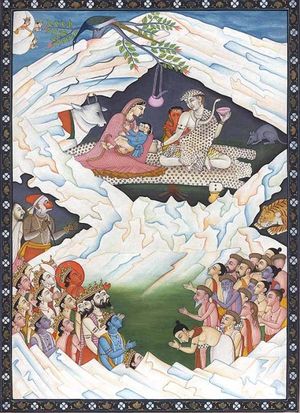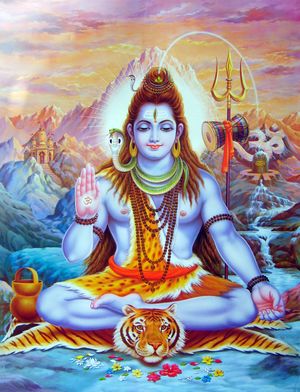Shiva/es: Difference between revisions
(Created page with "Cantar bhajans, con el corazón y la voz elevada en alabanza sublime a Shiva, es una de las formas en la que los devotos se acercan a su Señor....") |
(Created page with "A medida que el alma cultiva el amor supremo por Shiva, él viene como el Gurú a salvar al alma, despertarla a su realidad interna y purgarla de todos los amores inferiores....") |
||
| Line 20: | Line 20: | ||
Cantar [[Special:MyLanguage/bhajan|bhajan]]s, con el corazón y la voz elevada en alabanza sublime a Shiva, es una de las formas en la que los devotos se acercan a su Señor. También le rezan, lo imitan, tienen fe en su gracia y compasión, y veneran su imagen. En el bhakti yoga, la deidad representa al [[Special:MyLanguage/Atman|Atman]]: el Dios que mora en el interior, el núcleo incorruptible y sin decaer del hombre. A medida que el discípulo adora su ideal elegido, no solo despliega su propia divinidad latente, sino que también se convierte en uno con su amada. El objetivo de las amantes de Shiva es adquirir "shivatva", la naturaleza de Shiva. | Cantar [[Special:MyLanguage/bhajan|bhajan]]s, con el corazón y la voz elevada en alabanza sublime a Shiva, es una de las formas en la que los devotos se acercan a su Señor. También le rezan, lo imitan, tienen fe en su gracia y compasión, y veneran su imagen. En el bhakti yoga, la deidad representa al [[Special:MyLanguage/Atman|Atman]]: el Dios que mora en el interior, el núcleo incorruptible y sin decaer del hombre. A medida que el discípulo adora su ideal elegido, no solo despliega su propia divinidad latente, sino que también se convierte en uno con su amada. El objetivo de las amantes de Shiva es adquirir "shivatva", la naturaleza de Shiva. | ||
A medida que el alma cultiva el amor supremo por Shiva, él viene como el Gurú a salvar al alma, despertarla a su realidad interna y purgarla de todos los amores inferiores. Al contemplar continuamente su nombre y su imagen, al abandonar todo lo que no es Shiva, las distracciones de la mente y los placeres temporales de los sentidos, el alma se convierte únicamente en una criatura de la voluntad divina. Ella se desplaza y estimula con la danza cósmica de Shiva, hasta que ella y Shiva por fin son una. "Nadie sabe dónde reside el Señor [Shiva]", dice Tirumular, el santo y yogui que escribió más de tres mil himnos a Shiva. “Para los que lo buscan, él reside eternamente en su interior. Cuando veas al Señor, tú y él se convertirán en uno”. | |||
[[File:Hindukailash.JPG|thumb|upright=1|Shiva, Parvati and their sons at Mount Kailas (18th century)]] | [[File:Hindukailash.JPG|thumb|upright=1|Shiva, Parvati and their sons at Mount Kailas (18th century)]] | ||
Revision as of 00:49, 17 April 2020

Shiva es una de las deidades más populares en la India. Junto con Brahma y Vishnú, forma parte de la triada hindú, la trimurti. Brahma, Vishnú y Shiva se considran como tres manifestaciones del Ser Supremo Único. Son el "tres en uno", correspondientes a la Trinidad occidental de Padre, Hijo y Espíritu Santo. Brahma personifica el aspecto creador de Dios, Vishnú el preservador y protector, y Shiva el destructor o disolvente. Shiva encarna todos estos aspectos para los hindúes que lo eligen como su deidad.
Los devotos de Shiva lo reverencian como la Realidad suprema, la Divinidad total. Lo ven como el Gurú de todos los gurús, el destructor de lo mundano, la ignorancia, el mal y los malhechores, el odio y la enfermedad. Otorga sabiduría y larga vida, y encarna la renuncia y la compasión.
Creencias hindúes
El nombre Shiva se deriva del término sánscrito que significa "auspicioso", "amable" o "amigable". Los muchos aspectos y funciones de Shiva están representados en los varios nombres que se le atribuyen. Las escrituras hindúes llamadas Shiva-Purana contienen 1 008 nombres de Shiva. Uno de ellos es Shambu, que significa "benevolente" o que "provoca felicidad". Otro nombre es Shankara, que significa "dador de alegría" u "otorgador del bien". Como Mahadeva, él es el "gran dios".
Pashupati es otro de sus epítetos, que significa "señor del ganado". Como Señor del Ganado, Shiva es el ganadero o pastor de las almas. Shiva está representado a lomos de un toro blanco llamado "feliz". Según la tradición hindú, era uno de los devotos de Shiva que asumió la forma de un toro porque el cuerpo humano no era suficientemente fuerte para contener el éxtasis divino por Shiva. Nandi simboliza el alma del hombre que anhela a Dios. También representa el alma que contempla profundamente a Shiva como la Realidad suprema. Shiva nos ayudará a abrir nuestra Realidad suprema.
La devoción a Shiva
La adoración a Shiva tiene su origen en la tradición del bhakti yoga, el sendero de la unión con Dios a través del amor. El devoto elige una deidad o encarnación específica de Dios a quien le da toda su devoción. Él ama este aspecto de Dios más que a nada ni a nadie.
Cantar bhajans, con el corazón y la voz elevada en alabanza sublime a Shiva, es una de las formas en la que los devotos se acercan a su Señor. También le rezan, lo imitan, tienen fe en su gracia y compasión, y veneran su imagen. En el bhakti yoga, la deidad representa al Atman: el Dios que mora en el interior, el núcleo incorruptible y sin decaer del hombre. A medida que el discípulo adora su ideal elegido, no solo despliega su propia divinidad latente, sino que también se convierte en uno con su amada. El objetivo de las amantes de Shiva es adquirir "shivatva", la naturaleza de Shiva.
A medida que el alma cultiva el amor supremo por Shiva, él viene como el Gurú a salvar al alma, despertarla a su realidad interna y purgarla de todos los amores inferiores. Al contemplar continuamente su nombre y su imagen, al abandonar todo lo que no es Shiva, las distracciones de la mente y los placeres temporales de los sentidos, el alma se convierte únicamente en una criatura de la voluntad divina. Ella se desplaza y estimula con la danza cósmica de Shiva, hasta que ella y Shiva por fin son una. "Nadie sabe dónde reside el Señor [Shiva]", dice Tirumular, el santo y yogui que escribió más de tres mil himnos a Shiva. “Para los que lo buscan, él reside eternamente en su interior. Cuando veas al Señor, tú y él se convertirán en uno”.

Attributes of Shiva
Shiva is a study in contrasts. He symbolizes both contemplation and action. He is often shown deep in meditation as a mendicant yogi. As the Maha Yogi, or great yogi, he is the King of Yogis, the supreme embodiment of the spirit of asceticism. Shiva also personifies the dynamic universe. In the Hindu scripture Kurma-Purana, Shiva says: “I am the originator, the god abiding in supreme bliss. I, the yogi, dance eternally.”[1]
According to Hindu belief, Shiva performs a variety of dances. One of his dances is called the Tandava. This is his dance of creation and destruction. Shiva dances the universe into being, sustains it and then dances it out of existence at the end of an age. The most celebrated representation of Shiva is that of Nataraja, the King of Dancers, or Lord of the Dance. The place of Nataraja’s dance is the golden hall at the center of the universe. This golden hall represents the heart of man. One Hindu hymn that celebrates Shiva’s dance says that “as he dances, he appears in the immaculate lotus of the heart.”[2]
Mount Kailas
► Main article: Mount Kailas
Mount Kailas is Shiva’s throne and the location of his paradise. This majestic mountain is the highest point of the Kailas mountain range in the Tibetan Himalayas. Hindus revere Kailas as the most holy mountain in the world and make pilgrimages there.
The relationship of Shiva with his devotees is an intensely personal one. Although he resides at Kailas, his favorite home is in the heart of his devotees.
The Ganges River
According to Hindu tradition, when the gods decided to allow the Ganges River to descend from heaven, Shiva received the full impact of the massive weight of the falling water on his head lest the earth be shattered by the gigantic torrent. Shiva’s matted hair tamed the rushing cascade. He divided it into seven holy rivers, and the waters descended gently to earth.
To Hindus, the Ganges represents the refreshing river of spiritual wisdom. According to Hindu tradition, when the gods decided to allow that Ganges River to descend from heaven, Shiva in that point of the vortex of light, the whirling energy around him, was actually the balance between heaven and earth of the river that descended, which was a river of light and became the river of earth. And so the water of the Ganges is considered by Hindus to be a magical water, a holy water that purifies anything. The ascended masters teach that these seven holy rivers also represent the seven rays of the Holy Spirit that come out of the white light.

His teaching
Shiva’s role parallels that of the Holy Spirit in the Western Trinity. Shiva teaches that the threefold flame in your heart is the personification of Brahma, Vishnu and Shiva. He says:
You can see those three plumes as ourselves personified. Then you may talk to us. We are not a three-headed god, but Three-in-One, for we also have a threefold flame....
It is well for a time to visualize us personally rather than simply as an impersonal flame that is burning. Meditate upon us not as statues or pagan gods but as the very fire and the replica of the Godhead that has been placed in your heart.
Shiva says that he is always near at hand to answer your prayers.
You do not need to call me with a long and loud call as if I were far away! A simple signal will suffice, for I am the genie of the ruby ray. I am always ready! Turn your life around with me, and I will show you my cosmic dance. And I will dance with you and whirl in the sphere of fire. Yes, I shall show you how imminent is your victory.[3]
Lord Shiva encourages us to try an experiment for overcoming negative habits. He says:
Give yourself a cycle to rise to a plane of greater dominion. Make a God-determination. Think now of a very certain condition within your consciousness that you know absolutely must go. Think of that human consciousness. Think of that problem or habit that has gnawed at you and kept you from your eternal salvation.
Now, beloved ones, I ask you, be a scientist of the New Age and try this one experiment for the next forty-eight hours: Each time you face that momentum—that memory, that consciousness, that habit or that desire, whatever it is that you long to see put into the flame—each time it crosses the line of the mind, the desire body, or your big toe, each time it comes into the memory, speak into it with the full ferocity of your voice: “Shiva! Shiva! Shiva! Shiva!”[4]
Feminine counterparts
In Hindu tradition, every masculine personification of God has a feminine counterpart, or shakti. The masculine creative power is activated by this feminine principle. Thus, Shiva’s action is crystallized in the world of form through his female counterpart. His hidden nature is made visible through her. Shiva’s shakti appears in three primary forms—as Parvati, Durga and Kali.
See also
Sources
Mark L. Prophet and Elizabeth Clare Prophet, The Masters and Their Retreats , s.v. “Shiva, Parvati, Durga and Kali.”
Shiva! Sacred chants from the heart of India, audio album, liner notes.
- ↑ Stella Kramrisch, The Presence of Shiva (Princeton, N.J.: Princeton University Press, 1981), p. 439.
- ↑ Ibid., pp. 439–40.
- ↑ Lord Shiva, “The Power of Change,” Pearls of Wisdom, vol. 34, no. 62, December 1, 1991.
- ↑ Lord Shiva, “The Touch of Shiva: The Initiation of Love,” Part 2, Pearls of Wisdom, vol. 21, no. 47, November 19, 1978.
